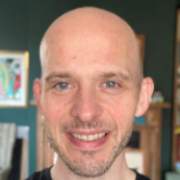A long-term ambition
The idea behind our new Biotechnology and Biological Sciences Research Council (BBSRC) sLoLa project has been incubating for some time. In fact, the inception of the project can be traced back to my time as a postdoctoral scientist working alongside Bruce Lichtenstein, a co-investigator on this sLoLa project.
Bruce and I met while working on the de novo design of redox proteins in Professor Les Dutton’s group at the University of Pennsylvania. He was a PhD student in the lab at the time.
Between experiments, we often discussed the future of the protein design field, an area that was evolving rapidly at the time, while adding to our ever-increasing wish list of research projects.
But what were the most ambitious and potentially transformative projects we could think to undertake if we had the backing?
At the top of the list was designing and building complex protein-based, electron-transporting circuits and artificial respiratory complexes.
Some years later, we’re thrilled to get a chance to take on this research challenge in collaboration with an exceptional team of researchers from across the UK.
The circuitry of life
Our sLoLa project aims to deepen our fundamental understanding of the molecular circuitry underpinning life itself.
Both cellular respiration and photosynthesis, the reactions that convert energy into forms usable by life, are reliant on the flow of electrons and energy through complex protein circuits. However, despite their importance, we still don’t fully know how these systems work at a biophysical level.
We plan to address this knowledge gap by creating novel redox and light-harvesting enzymes and using these to construct artificial electron-transporting circuits.
These artificial circuits will provide a platform for us to test theory and clarify unresolved details of how electron and energy transfer work in their natural counterparts.
Additionally, by learning as we build, we will derive the engineering biology principles necessary to allow us to exploit the properties of the natural circuits on our own terms.
This could lead to several interesting future applications such as bioelectronic sensors and industrial-scale light energy harvesting.
Bringing together the right team for the challenge
The scale of this challenge is great.
Addressing it will require knowledge and experience of:
- redox protein engineering
- biomolecular simulation
- computational modelling
- ultrafast spectroscopy.
No one research group is equipped with the necessary expertise to go at it alone.
This is where team science comes in.
Team science brings together multiple research groups to address a research challenge from different disciplinary perspectives.
Working as a single coordinated consortium strengthens research capabilities and ensures that individual efforts and outputs are fully aligned. This synergy would prove considerably more difficult if groups were working in isolation on several disjointed projects.
Unique role to play
For this sLoLa project, I have convened a team comprising seven co-investigators and several more collaborators. Each team member has a unique role to play and without exception is essential to the delivery of the project.
Although some team members have collaborated for several years, I had to reach beyond my usual networks to ensure that all project requirements were covered.
Julea Butt, who I have long admired but have never worked with previously, is one such example of where I had to do this.
Julea brings a wealth of experience in protein electrochemistry and electron transfer through natural protein wires, which complements the expertise of the rest of the team perfectly.
Ensuring legacy
However, there is more to team science than just addressing the challenge at hand. This type of science offers a unique opportunity to make an impact on the vitality of bioscience long into the future.
We will realise this by establishing a diverse community of biophysical and biochemical researchers, who I hope will continue to take on complex research challenges long after our sLoLa project ends.
Moreover, we aim to cement our project’s legacy by creating an environment where postdoctoral scientists and researcher co-investigators work across disciplinary boundaries, with different mentors and at different research institutions.
This collaborative style of working is essential in modern biosciences research. By embedding close cooperation and lab exchanges within our project, we will equip the researchers involved with the cross-disciplinary skills and collaborative experience needed to thrive in their future careers.
Leading a team science project
I know that leading a large, multi-investigator project of this scale for the first time will not be without its challenges.
For example, being able to maintain sufficient levels of communication between the different physical locations involved is a challenge that has been on my radar from an early stage.
However, I feel like now is the right time in my career to take on these new leadership challenges.
Over the past few years, I’ve been responsible for organising conferences and leading academic units at undergraduate and postgraduate levels.
This has allowed me to gain valuable experience of coordinating the activities of a diverse grouping of people spread over disparate locations (especially true during the COVID-19 pandemic). It has also further developed my ability to respond quickly when things don’t go to plan and to mediate when necessary.
These skills will no doubt prove invaluable in ensuring the successful delivery of our sLoLa project.
But just as a team science endeavour is required to address the scientific challenges of our project, the same will be true of leading it.
Bringing complementary leadership skills
Whilst I am the principal investigator responsible for the overall direction and coordination of our sLoLa project, each co-investigator brings complementary leadership skills to the group.
As experts in their respective fields, they will of course lead their own group’s scientific work. In addition, they will contribute their collective management experience to the project as a whole.
To facilitate this, I will convene and chair a management group so that we can shape the direction of our research together.
The wider team is extremely important and encompasses:
- co-investigators
- postdoctoral scientists
- collaborators
- graduate students
- technicians
- administrative professionals.
Only through the collective efforts of the wider team will we be able to realise the full potential of our ambitious sLoLa project.
About sLoLa funding
Advancing the frontiers of bioscience discovery is a strategically important objective of the BBSRC Delivery Plan.
The longer-term, larger-scale support offered through the sLoLa scheme enables BBSRC to take ‘bigger bets’ on ambitious programmes in transformational areas of research.
By supporting creative, curiosity-driven research at the limits of our current understanding, BBSRC aims to catalyse exciting discoveries that may have far reaching implications for science, society and the economy.
The fourth round of sLoLa funding since the scheme relaunched in 2018 is ongoing and a fifth round is now open for registration by interested parties.
Top image: Credit: nicolas_ , E+ via Getty Images




